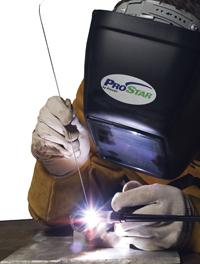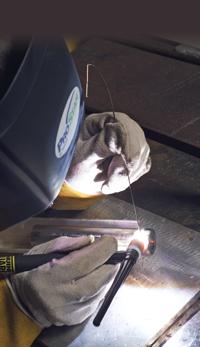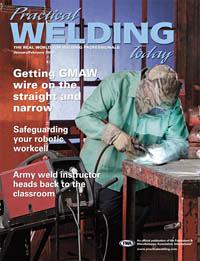Marketing Manager, Metal Fabrication
- FMA
- The Fabricator
- FABTECH
- Canadian Metalworking
Categories
- Additive Manufacturing
- Aluminum Welding
- Arc Welding
- Assembly and Joining
- Automation and Robotics
- Bending and Forming
- Consumables
- Cutting and Weld Prep
- Electric Vehicles
- En Español
- Finishing
- Hydroforming
- Laser Cutting
- Laser Welding
- Machining
- Manufacturing Software
- Materials Handling
- Metals/Materials
- Oxyfuel Cutting
- Plasma Cutting
- Power Tools
- Punching and Other Holemaking
- Roll Forming
- Safety
- Sawing
- Shearing
- Shop Management
- Testing and Measuring
- Tube and Pipe Fabrication
- Tube and Pipe Production
- Waterjet Cutting
Industry Directory
Webcasts
Podcasts
FAB 40
Advertise
Subscribe
Account Login
Search
A shielding gas primer for GTAW
Gas selection and optimization
- By W.F. Garth Stapon
- January 27, 2009
- Article
- Consumables
Selecting the most economical shielding gas or blend for gas tungsten arc welding (GTAW) must be based on your knowledge of the gases available, volume requirements, applications, and the overall effect the gas has on the welding process.
The primary gases used for GTAW are argon, helium, hydrogen, and sometimes nitrogen. The composition and purity of the gas or gas mixture should be tailored to meet your process, material, and application requirements. Shielding gases are used in either pure form or in blends of varying components. Therefore, selecting a gas or gas mixture can become quite complex because of the many combinations available.
Characteristics that influence gas selection criteria include heat input to the workpiece, specific gravity, arc starting and stability, and desired penetration profile. To ensure that you select the most appropriate shielding gas for your GTAW application, it is important to understand a few of the fundamental characteristics that apply to these gases at the elevated temperatures present in the arc.
Shield Gases and Their Properties
Argon. Slightly less than 1 percent of the earth's atmosphere is composed of argon, which is colorless, odorless, tasteless, and nontoxic. As an inert gas, argon does not react with other compounds or elements. It is about 1.4 times heavier than air and cannot sustain life. The inert properties of argon make it ideal as a shield against atmospheric contamination, which is why it is used in many welding processes. Argon promotes good arc-starting characteristics and arc stability because of its low ionization potential.
Helium. The second-lightest element after hydrogen, helium is lighter than air. Like argon, it is chemically inert and will not sustain life. Due to its high thermal conductivity and high ionization potential, helium is used as a shielding gas when increased heat input is desired and low tolerance for oxidizing elements exists, such as with aluminum and magnesium welding.
Since heat in the arc is roughly measured by the product of current and voltage (arc power), the use of helium yields a much higher available heat than does argon used alone. This is one reason that helium is commonly referred to as a "hotter" gas. This property can become advantageous particularly when welding heat-conductive materials such as aluminum and copper alloys.
Use of an argon blend with gas additions such as helium will provide greater thermal conductivity. This will result in a broader, hotter arc. The type of heat distribution that occurs with pure helium and helium/argon blends provides deeper, broader penetration when compared with the use of argon alone.
Hydrogen. The lightest known element, hydrogen is a flammable, non-life-sustaining gas. Explosive mixtures can be formed when certain concentrations of hydrogen are mixed with oxygen, air, or other oxidizers. Small quantities are useful in gas blends for plasma cutting and some welding applications because of its high thermal conductivity and reactive nature. It is a very useful addition to argon for GTAW on 300 series austenitic stainless steels and as added in controlled amounts to argon to be used as a purge gas when working with 300 series stainless steel pipe (less than 5 percent).
Hydrogen is a reactive gas, but provides a reducing effect when it's used as a component part in a shielding gas mixture. At elevated temperature, hydrogen will (preferentially) react with oxidizing agents, thereby helping to prevent the formation of oxides in the molten weld metal.
For the 300 series stainless family, even a small addition of hydrogen to an argon blend (less than 10 percent hydrogen) can dramatically increase the thermal conductivity when compared with argon alone and will enhance process productivity, especially when welding a 300 series stainless and some high-nickel alloys such as INCONEL® grades 718 and 625.

For heat-conductive metals such as aluminum and copper alloys, an argon/helium shielding gas mixture will improve the weld deposit penetration profile and may enhance welding productivity when compared with using argon alone. Photo courtesy of Praxair Inc.
In carbon steel joining, hydrogen can produce detrimental effects, such as underbead cracking, when used on some high-strength and low-alloy steels.
Leak Detection Methods
Distribution leaks can be identified with several methods, including analytical equipment. The following is a list of accepted leak detection methods:
- Leak solution or an oil-free soap solution mixed with water
- Ultrasonic
- Volumetric bubble collection
- Thermal conductivity
- Halogen detector (tracer gas)
- Residual gas analyzer
- Helium mass spectrometry
Nitrogen. Nitrogen is a colorless, odorless, and tasteless gas that forms 78 percent of the earth's atmosphere (by volume). It is nonflammable, does not support combustion, and is slightly lighter than air. Nitrogen is inert except at arc welding temperatures, where it will react with some metals such as aluminum, magnesium, and titanium.
It is not recommended as a primary shielding gas with GTAW, but is commonly applied as an assist gas with laser cutting on stainless steels. It can be used in combination with other gases for some welding and purging applications, and it is also widely used in plasma and laser cutting. Recent work has shown that controlled additions of nitrogen to argon can improve weld metal corrosion resistance with duplex stainless steels. Nitrogen can also be mixed with controlled amounts of hydrogen to be used as an economical alternative for purging 300 series stainless steel pipe (less than 2 percent hydrogen).
Getting the Most From Your Shield Gas
There's more to successful gas blend selection in GTAW than just knowing the basic properties of the gases themselves; it also involves knowing how to optimize the gas blends that you've chosen.
Gas Purity. Depending on the metal being welded, even minuscule gas impurities can have a detrimental impact on travel speed, surface appearance, weld quality, and porosity levels. Impurities are most often introduced into the gas stream via a leak in the gas distribution system.
The purity of industry-accepted, welding-grade argon is 99.995 percent. In many cases, source purity is less than this because of the presence of leaks in the gas distribution system. The impact of the leak is determined by the base metal type. For example, carbon steel is more tolerant to minor amounts of atmospheric oxygen than is titanium. Consult with your local gas supplier on the best way to make your shielding gas distribution system leak-free. See Leak Detection Methods Sidebar for ways to ensure gas purity.
Thermal Conductivity. The thermal conductivity of a shielding gas is related to its ability to conduct heat. Gas type and mixture composition influence the radial heat loss from the center to the periphery of the arc column. When used as a shielding gas, pure argon has mild thermal conductivity and produces an arc that has two zones: a narrow hot core and a considerably cooler outer zone. Helium has higher thermal conductivity than argon and will almost always broaden and deepen penetration patterns.
As a rule of thumb, you should consider using pure argon when welding base metals less than 1.6 mm thick. As base metal thickness increases, or if you are welding on aluminum or copper, consider using a blend that will have greater thermal conductivity than argon would if used alone. Gas selection must be based on the grade, thickness, welding position, and type of material being welded.
Gas Flow Rate. Gas flow rate, which can be 10 cubic feet per hour (CFH) to more than 60 CFH, depends on the current developed, torch size, shielding gas composition, welding position, operating current, and the surrounding work environment.
In general, a higher operating current will require a larger torch nozzle and higher gas flow rates. Operating currents that are greater than 150 amps should also dictate the use of a water-cooled GTAW torch. This will help to control the heat buildup, may allow the use of a smaller tungsten diameter, and will reduce operator fatigue. In addition, gas density, or the weight of the gas relative to air, has a major influence on the minimum flow rate required to effectively shield the weld.
Argon is approximately 1.4 times as heavy as air and 10 times as heavy as helium. This means that gas flow rates must be increased to maintain quality when working in the vertical or overhead welding position. Conversely, helium can be a more effective alternative to argon when working overhead as this gas floats. When working in the flat position with helium-enhanced blends, it is always necessary to increase gas flow to maintain weld quality when compared to using argon alone. Flow can be 50 percent or more than what is typically required with pure argon.
Gas Conservation. It's a general perception among welders that using more shielding gas is always better. In many cases, however, excessive shielding gas flow can cause a venturi effect, which may result in drawing atmospheric contamination into the weld zone. In the worst-case scenario, this can cause weld failure.
Often physical gas flow measurements at the point of use show an opportunity to reduce the shielding gas flow rate for a given application. Another opportunity to conserve gas is via process optimization. Using a gas lens in the torch will help you to stabilize gas flow and will almost always result in using less gas to complete the same amount of work.
Pre- and Postflow. When welding on base metals that are sensitive to oxidation, such as copper, aluminum, and stainless steel, using controlled amounts of gas preflow and postflow will help you to minimize contamination of the weld zone and electrode.
Preflow shielding gas for 1 to 3 seconds to remove moisture that may have entered the gas delivery system. An additional benefit includes blanking of the weld zone for optimum starting conditions.
Changes in room temperature can cause air to move in and out of the end of a torch while not in use, which can cause moisture in the air to condense on the inside of the torch. A preflow of shielding gas for a period of time before the arc is initiated will remove the moisture.
In some critical GTAW applications, it is common to run a low flow (1 to 2 CFH) of shielding gas through the torch during downtime to help prevent atmospheric contamination in the gas delivery system. A reverse-flow check valve is also suggested for critical applications.
Postflow requirements are driven by the operating current and the type of base metal you are welding. A rule of thumb is 1 second for every 10 amps of operating current, although a carbon steel weldment would not require as much postflow as a titanium- alloy weldment. Consult with your local welding supplier on its recommendations for postflow on your application.
Shield Gas Development: A Historical Perspective
The history of shielding gas development began late in the 19th century when Charles Lewis Coffin replaced the air in a box placed over a welding joint with a nonoxidizing atmosphere. Interest in the use of inert, nonoxidizing gases for welding was sporadic for the next 40 years. In 1930 two U.S. patents were issued that are considered to be the first descriptions of the use of inert shielding gases for welding.
The first patent, issued to H.M. Hobart, described the use of helium with carbon or metallic arcs. The other, issued to P.K. Devers, described the use of argon and its mixtures for arc processes.
In the early 1940s, Northrop Aircraft Co. Inc. first used an inert gas-shielded welding process with a nonconsumable tungsten electrode. The process was developed specifically for welding magnesium for aircraft fabrication using helium as the shielding gas.
Reference:Praxair Shielding Gases Selection Manual
About the Author
W.F. Garth Stapon
39 Old Ridgebury Road
Danbury, CT 06810
800-225-8247
About the Publication
subscribe now

The Welder, formerly known as Practical Welding Today, is a showcase of the real people who make the products we use and work with every day. This magazine has served the welding community in North America well for more than 20 years.
start your free subscription- Stay connected from anywhere

Easily access valuable industry resources now with full access to the digital edition of The Fabricator.

Easily access valuable industry resources now with full access to the digital edition of The Welder.

Easily access valuable industry resources now with full access to the digital edition of The Tube and Pipe Journal.
- Podcasting
- Podcast:
- The Fabricator Podcast
- Published:
- 04/16/2024
- Running Time:
- 63:29
In this episode of The Fabricator Podcast, Caleb Chamberlain, co-founder and CEO of OSH Cut, discusses his company’s...
- Trending Articles
Sheffield Forgemasters makes global leap in welding technology

Welding student from Utah to represent the U.S. at WorldSkills 2024

Lincoln Electric announces executive appointments

Engine-driven welding machines include integrated air compressors

ESAB unveils Texas facility renovation

- Industry Events
16th Annual Safety Conference
- April 30 - May 1, 2024
- Elgin,
Pipe and Tube Conference
- May 21 - 22, 2024
- Omaha, NE
World-Class Roll Forming Workshop
- June 5 - 6, 2024
- Louisville, KY
Advanced Laser Application Workshop
- June 25 - 27, 2024
- Novi, MI



























